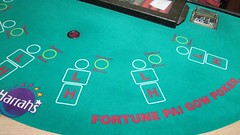If you are keen to switch up your gameplay on the casino floor and try something new, Pai Gow Poker could be a good starting point. This table game staple has been increasingly popular over the last couple of decades since it was created by American casino mogul, Sam Torosian. Mr Torosian introduced Pai Gow Poker to his customers at the Bell Card Club in California and eyebrows were quickly raised at how simple the gameplay was and how it appealed to players that prefer low-risk gaming.
What is Pai Gow Poker?
Put simply, Pai Gow Poker was created as an “Americanized” answer to the Chinese dominoes-based game known as pai gow. The game mechanics of Pai Gow Poker are very similar to that of blackjack, which sees players play their hand against the dealer and the dealer only. This helps to create a hugely social and engaging table game among casino players.
The basis of Pai Gow Poker sees each playing card assigned a numerical value and arranged into conventional hands used in Texas Hold’em Poker. This means that Pai Gow Poker doesn’t just appeal to those who enjoy playing dominoes and blackjack but poker too.
The key rules of Pai Gow Poker
A typical game of Pai Gow Poker sees a maximum of six people sit down at a table, with one dealer overseeing every hand dealt. Every player is then dealt seven cards from a single 52-card deck, along with an added joker. The four remaining cards not used between the six players and the dealer are discarded.
The aim of the game is to use those seven cards to create two poker hands capable of defeating the dealer’s two hands. The first hand, called the “back hand”, needs to comprise of five cards. The second hand, known as the “front hand” should feature two cards only.
The back hand should always be a higher-value poker hand than the front hand. Once each player has laid out their respective back and front hands, they will be compared with the dealer’s hands and wagers will be won or lost at this stage.
If both a player’s hands are better than the dealer’s, they are paid even money in winnings. If just one of a player’s hands defeat the dealer’s hands, their wager is “pushed” or voided, meaning the stake is returned to the player. If both a player’s hands are worse than the dealer’s, their wager is lost to the dealer.
The joker cards can be used at any point to replace a card to complete a flush of any suit or to complete a straight. In the event it cannot be used to finalize a flush or straight, the joker has the value of an ace.
Although the majority of hands are ranked in the same hierarchy as a conventional game of poker, Pai Gow Poker’s second-highest straight is actually an Ace-to-5 back hand, which is known in Pai Gow Poker as “the wheel”.
What makes a successful Pai Gow Poker strategy?
If you’re wondering how to increase your chances of winning a hand of Pai Gow Poker at the tables, read on:
- If you don’t have a pair, flush or straight to make, always play the highest-value card in your back hand and the following two highest-ranking cards in your front hand.
- If you have two pairs, with one of those pairs being a pair of aces, split them. If one of those pairs is a pair of kings, split them unless the other pair is a pair of twos.
- If you have two pairs of sixes and lower, split them unless you have an ace, in which case you can play them together with the ace in the back hand.
- If you have two pairs of sevens through to tens, split them unless you have an ace to use alongside in your back hand.
- If you have two pairs of jacks through to aces, split, using the highest pair in the back hand.
- Those with three pairs in their seven cards should place their highest-value pair in the front hand.
- Three-of-a-kind hands should always be played in the back hand, except when it’s a trio of aces, in which case one of those aces should be put in the front hand.
- Full house hands should be split with the single pair placed in the front hand.
- Straights and flushes should be kept in the back hand, unless you have a pair of tens or higher too. In which case, it’s better to split the straight or flush.
- Four-of-a-kind sixes or lower should be kept together in the back hand.
- Four-of-a-kind sevens through to ten should be split, unless an ace is available to use in the front hand.
- Four-of-a-kind face cards should be split, unless another pair is available to use in the front hand.
Banking in Pai Gow Poker
At Pai Gow Poker tables in land-based casinos, the dealer will sometimes ask players if they wish to be the “banker”. This means a player can play their hand against their opponents as well as the dealer’s. Although this might sound risky, it can actually shift the odds in your favor.
As the banker, you win “ties”, so when you and your opponents have one higher hand each, you win. It reduces the house edge to just 1.46% during any “banker” hands. It’s something to bear in mind once you improve your skills and want to maximize your income.







